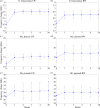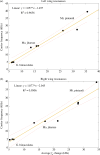Changes in wing resonance in dried preserved crickets
- PMID: 39698161
- PMCID: PMC11651895
- DOI: 10.1098/rsos.241147
Changes in wing resonance in dried preserved crickets
Abstract
Male crickets sing to attract females for mating. Sound is produced by tegminal stridulation, where one wing bears a plectrum and the other a wing vein modified with cuticular teeth. The carrier frequency (fc ) of the call is dictated by the wing resonance and the rate of tooth strikes. Therefore, the fc varies across species due to the size of the vibrating membranes on the wings and/or the speed of tooth strikes. But how well is the resonant frequency (fo ) conserved in dried preserved specimens? This project is designed to investigate the gradual change in cricket wing fo over time and aims to produce equations that help to predict or recover the original natural frequency of wing vibration in dry-preserved crickets and allies. Using laser Doppler vibrometry, we scanned the wings of living specimens to determine their fo . The specimens were then preserved, allowing us to continue measuring the wings fo as they desiccate. We found that after the first week, fo increases steeply, reaching a plateau and stabilizing for the following months. We go on to propose a model that can be used to recover the original fc of the wings of preserved Ensifera that use pure tones for communication. Models were corroborated using preserved specimens previously recorded and mounted in dry collections for more than 10 years.
Keywords: Ensifera; carrier frequency; desiccation; laser Doppler vibrometry; stridulation; wing resonance.
© 2024 The Authors.
Conflict of interest statement
We declare we have no competing interests.
Figures







References
-
- Bailey WJ. 1970. The mechanics of stridulation in bush crickets (Tettigonioidea, Orthoptera) I. Tegminal generator. J. Exp. Biol. 52, 495–505. (10.1242/jeb.52.3.495) - DOI
-
- Simmons LW, Ritchie MG. 1996. Symmetry in the songs of crickets. Proc. R. Soc. Lond. B 263, 1305–1311. (10.1098/rspb.1996.0191) - DOI
-
- Heller KG, von Helversen D. 1986. Acoustic communication in phaneropterid bushcrickets: species-specific delay of female stridulatory response and matching male sensory time window. Behav. Ecol. Sociobiol. 18, 189–198. (10.1007/BF00290822) - DOI
-
- Jonsson T, Montealegre-Z F, Soulsbury CD, Robert D. 2021. Tenors not sopranos: bio-mechanical constraints on calling song frequencies in the Mediterranean field-cricket. Front. Ecol. Evol. 9. (10.3389/fevo.2021.647786) - DOI
Associated data
LinkOut - more resources
Full Text Sources
Miscellaneous

